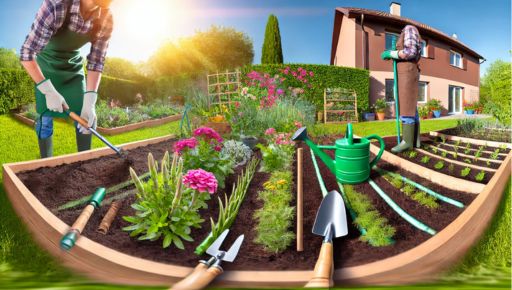A home garden is an oasis that not only enhances the beauty of your living space but also provides fresh, homegrown produce. Whether you have a sprawling backyard or a small balcony, cultivating a home garden can be a rewarding experience. In this article, we’ll guide you through the essentials of creating and maintaining a successful home garden, from planning to planting and upkeep.
Benefits of a Home Garden
Creating a home garden offers numerous benefits. Firstly, it’s a fantastic way to add aesthetic value to your home, turning your outdoor space into a peaceful retreat. Additionally, gardening allows you to grow fresh fruits, vegetables, and herbs, which can significantly reduce grocery costs. Beyond that, growing your own produce ensures that you’re consuming food free from harmful pesticides and chemicals.
Gardening also has health benefits, as it provides a moderate form of exercise. From planting to weeding, these activities keep you active while enjoying the outdoors. Gardening can even have mental health benefits, reducing stress and promoting relaxation. Many people find it therapeutic to connect with nature while tending to their plants.
Planning Your Home Garden
The first step to creating a thriving home garden is careful planning. You need to consider your space, climate, and the amount of sunlight your garden will receive. The location of your garden will determine what types of plants will thrive there. If you have a small balcony, vertical gardening techniques like using trellises or stacking pots can help maximize space.
Next, take into account the climate of your region. Different plants have different temperature and humidity needs. For instance, warm-weather crops like tomatoes and peppers are best suited for areas with long, hot summers, while cool-weather crops like lettuce and spinach thrive in cooler temperatures. Understanding your garden’s specific needs will help you make informed choices when selecting plants.
Selecting the Right Plants for Your Home Garden
Choosing the right plants is crucial for a successful home garden. Start by selecting plants that are well-suited to your climate and growing conditions. If you’re new to gardening, it’s a good idea to start with easy-to-grow vegetables such as tomatoes, carrots, and cucumbers. These plants are relatively low-maintenance and yield satisfying results.
Consider planting a variety of crops to ensure that you have a constant harvest throughout the season. Including herbs like basil, mint, or rosemary will not only enhance your meals but will also attract beneficial pollinators like bees and butterflies. Flowers like sunflowers, lavender, and marigolds can also add beauty to your garden while keeping pests away.
Preparing the Soil for Planting
Before planting, it’s important to prepare the soil properly. Healthy soil is the foundation of a thriving garden. Start by testing the pH of your soil, as this will determine which plants will grow best. Most plants prefer slightly acidic to neutral soil (pH 6-7), but some, like blueberries, require more acidic soil.
Add organic matter like compost to enrich the soil and improve its structure. Compost not only adds nutrients but also helps retain moisture, which is vital for plant health. If your soil is too sandy or clay-heavy, amend it with organic materials to improve its drainage and water-holding capacity.
Watering and Maintenance
Watering is one of the most crucial aspects of home garden maintenance. Plants require consistent moisture, but overwatering can lead to root rot. To prevent this, ensure that your garden beds have proper drainage. Water your plants deeply, especially during dry spells, but allow the soil to dry out between watering sessions to encourage deep root growth.
Mulching is another key practice for maintaining a healthy garden. Mulch helps retain moisture, suppress weeds, and regulate soil temperature. It also slowly breaks down and adds organic matter back into the soil. Wood chips, straw, or even grass clippings can make excellent mulch materials.
Dealing with Pests and Diseases
Pests and diseases are common challenges for home gardeners. Instead of resorting to harmful chemicals, consider using natural methods to control pests. For example, planting garlic or marigolds can repel insects, while introducing ladybugs can help control aphid populations.
If you notice signs of disease, remove the affected leaves or plants promptly to prevent the spread. Regularly inspecting your garden and practicing crop rotation can also reduce the risk of pests and diseases.
Harvesting Your Home Garden
One of the most rewarding parts of gardening is harvesting the fruits of your labor. Be sure to harvest your crops at the right time to enjoy them at their peak flavor and nutritional value. Most vegetables, such as tomatoes, zucchini, and peppers, are best harvested when they’re fully ripe but not overripe.
Regularly harvesting your plants will also encourage them to continue producing. For example, picking tomatoes regularly can lead to more fruit production. Remember, the more you care for your garden, the more it will reward you with bountiful harvests.
Conclusion
A home garden is an investment in your health, environment, and happiness. By planning carefully, choosing the right plants, and maintaining your garden properly, you can create a beautiful and productive space. Whether you’re growing flowers, herbs, or vegetables, the satisfaction of seeing your plants thrive and produce is one of the greatest joys of gardening. Start small, and gradually expand your garden as you gain more experience. With patience and dedication, you’ll soon be reaping the rewards of your hard work in your very own home garden.

